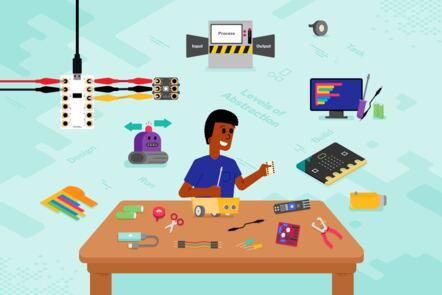MOOC List is learner-supported. When you buy through links on our site, we may earn an affiliate commission.

MOOC List is learner-supported. When you buy through links on our site, we may earn an affiliate commission.
On this three-week course from the Raspberry Pi Foundation, you’ll be introduced to the world of physical computing and how it can encourage learners to use their imaginations to solve problems and develop new ideas.
You’ll learn how to support young children aged 5-11 years old as they work through physical computing projects, whilst also developing your own knowledge and skills.
Gain an understanding of inputs and outputs
On the course, you’ll build projects involving connecting both inputs and outputs to a Crumble microcontroller or a BBC micro:bit.
You will use inputs to pass data into the microcontroller, process that data with block-based programming languages, and use outputs to move a robot buggy or provide information to a user.
The course will help you complete several physical computing projects to develop your skills and help you understand the experiences your young learners may have. You’ll also reflect on how your projects use the programming principles of sequence, selection, and repetition.
Learn how to adapt your lessons for young learners, with Raspberry Pi
On the course, you’ll find advice from the experts at Raspberry Pi Foundation on how to make the concepts relevant to young learners.
The projects that you work on also model the use of “levels of abstraction”, a way of splitting up computing projects to help focus on individual aspects, and lower cognitive load.
At the end of the course, you’ll create your own physical computing project involving a buggy to help cement your knowledge and put what you have learned into practice.
What topics will you cover?
- Using physical computing devices in primary school
- Using a Crumble to light LEDs and turn motors
- Using buttons and sensors as inputs to a Crumble
- The programming concepts of sequence, repetition, selection, and using variables
- Builidng a buggy with a Crumble
- An introductino to Micro:bit
Learning on this course
You can take this self-guided course and learn at your own pace. On every step of the course you can meet other learners, share your ideas and join in with active discussions in the comments.
What will you achieve?
By the end of the course, you‘ll be able to...
- Evaluate different commercially available physical computing tools
- Apply your programming knowledge to control digital inputs and outputs
- Develop physical computing projects using a Crumble microcontroller from task to completed build
- Demonstrate how to use the micro:bit MakeCode editor and emulator
- Design suitable physical computing projects for your learning context
- Reflect on your learning and create ideas for your classroom practice
Who is the course for?
This course is designed for educators of all types, in schools or informal settings.
It will help you begin your physical computing journey and use physical computing to help to teach young children how to program.
MOOC List is learner-supported. When you buy through links on our site, we may earn an affiliate commission.
MOOC List is learner-supported. When you buy through links on our site, we may earn an affiliate commission.
